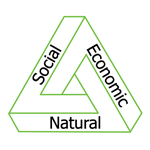
Principles of Sustainability
Chapter 2 - Standards of Sustainability
Part 3 - Sustainable Development

In the late 20th century, “sustainable development” emerged as the appropriate pattern of resource use to guide economic and physical development, within the context of long-view thinking about environmental and social imperatives. While there are no immediate answers or action plans that will insure global, national or even local sustainability, there are central organizing principles that can better guide development in a more sustainable direction. Sustainability requires enhanced management of the capital resources we have in our society and on the Earth. The three major types of capital are Natural Capital, Economic Capital, and Social Capital. In 1987, the World Commission on Environment and Development, also known as the Brundtland Commission defined sustainable development as “meet[ing] the needs of the present without compromising the ability of future generations to meet their own needs”.
Keywords
- sustainable development
- natural capital
- environmental capital
- social capital
- economic capital
- externalities
- market failure
- Willingness to Pay
- development
- Gross National Product (GNP)
- General Agreement on Tariffs and Trade (GATT)
- International Monetary Fund (IMF)
- Tragedy of the Commons
- Human Development Index (HDI)
Reading
- "Sustainable development in a post-Brundtland world" C. Sneddon, Howarth, R.B. and Norgaard, R.B. Ecological Economics, Volume 57, Issue 2, 1 May 2006, pp 253-268.
(Introduction adapted from the work of Wendy McClure, 2010)
